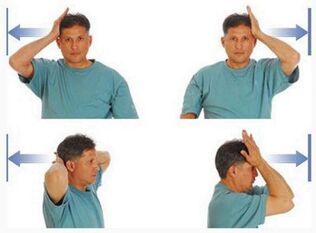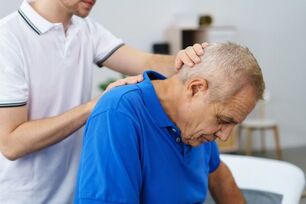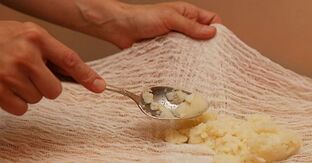Osteochondrosis can develop in any part of the spine, but in most cases it affects the neck and lumbar region. The disease is inflammatory-dystrophic in nature and usually persists in a chronic form. Cervical osteochondrosis is more commonly diagnosed in women, while men are more susceptible to lumbar osteochondrosis.
General Description
Most people spend their days sitting: at school, college, office, driving or at home on the computer. Over time, many begin to feel discomfort first, followed by pain after sitting for a long time. Posture worsens, a bend appears, it is difficult to straighten or turn.
The first stage of osteochondrosis, which is the easiest to cope with the disease, looks like this. If you do not take action, it threatens to turn into a chronic form with regular flare-ups in the future. In some cases, the work ends in disability.
USE: cervical spine osteochondrosis accounts for half of all pathological types.
The clinical picture of cervical chondrosis includes:
- pain syndrome caused by compression of nerve roots. Depending on which vertebrae and discs are damaged, the pain can spread to the shoulder, wrist or the whole arm. Headache is characterized by an increase in pressure;
- mainly sensory disorders in the hands and fingers. Perhaps numbness, a burning sensation, or crawling reptiles;
- Decreased strength and tone of the muscles on the affected side, sometimes muscle spasms and cramps;
- increased sweating, skin discoloration - paleness, redness;
- chest pain;
- vertebral artery syndrome occurs when one of the two arteries is constricted, which is accompanied by severe headache, tinnitus, nausea, dizziness, and less often - swallowing disorders.
There is no drug that can completely eliminate the cause of osteochondrosis. But you can get rid of the symptoms and prevent possible recurrences using the simplest methods.
How is chondrosis treated?
In the acute phase, rarely does anyone take pain medication. The most popular and effective are cheap drugs based on sodium metamizole, as well as NSAIDs - non-steroidal anti-inflammatory drugs.
A doctor involved in severe pain may prescribe injectable analgesics, but more often they are prescribed in tablets and supplemented with ointments. Complex therapy also includes physiotherapy, massage and sports therapy. Massage sessions and therapeutic exercises usually begin after the acute symptoms have resolved.
What can you do at home
Home treatment of cervical osteochondrosis is a condition that many doctors insist on. It is not possible to cope with the disease only with medication and physiotherapy, they only temporarily relieve the symptoms. The duration of remission can be extended by regular, dosed physical activity, self-massage techniques, therapeutic compresses and strengthening infusions.
Impressive results can be achieved by following the instructions exactly and following the medical recommendations. Self-massage saves a lot of money, and the use of decoctions and herbal infusions instead of some drugs reduces the negative effects of drugs on the body.
Home therapy, like traditional treatment, helps to quickly stop the pain syndrome, normalize cerebral circulation and improve sleep. With the help of available products you can eliminate nervousness and irritation, stabilize blood pressure, restore normal sensitivity of the neck and neck area.
exercise therapy
Therapeutic exercises are included in the basic treatment standard for cervical chondrosis and are selected by an exercise therapy instructor. The first 1-2 sessions are held in a clinic or health center, and then the patient can prepare himself at home.
Exercise 1. PI (starting position) - standing, feet shoulder-width apart. Turn your head to the right, left, forward and backward. All movements should be slow and smooth, do not throw your head back suddenly, take it back especially carefully.
Exercise 2. Turn your head to the side from the same PI. Focus your back on the extreme point. Sometimes you can't turn your head too much at first and you don't have to force events. Over time, the movement that restricts the "block" will disappear.
Exercise 3. Bring the shoulder blades back together as far as possible. Hold this position for a few seconds, then bring your shoulders forward and roll your back. The movement is similar to the famous "cat", but stands up.
Another effective set consists of the following exercises:
- When standing or sitting, place your palms on your forehead and press your head over the resistance of your hands. Hold this position for 15-20 seconds.
- Put your hands behind your head and squeeze the back of your head with your hands and the back of your head with your hands.
- Place your palm on your right ear and exert mutual pressure by trying to tilt your head to your right shoulder. Then change sides and turn your head to your left shoulder, holding your left hand on your left ear.
- Place the palm on the left or right cheekbone and turn the head to the side. At first, the hand extends to the right cheekbone and tries to turn to the right, overcoming the resistance of the head. Then the palm stands on the left cheek and the head turns to the left. Pressure duration is 15-20 seconds.
- Hold the lower part of the head so that the thumbs are on the chin and the rest are on the back of the head. Gently pull your head up, allowing it to swing from side to side, such as "removing the fungus from the glass. "You can not turn your head, the spine inside the cervical spine should be straightened. Training time is 15-20 seconds.
- Open your arms to the sides and turn first with your left, then with your right, then with both shoulders. This exercise is especially useful for those who feel tension in the neck and shoulders.
- Sit on your feet or straight back, "move" your head from left to right and vice versa, try to reach the chest with your chin, tilting as low as possible in the middle. The number of repetitions is 10-12.

If some exercises cause pain and severe discomfort, it is not necessary to complete the above complex. In consultation with your doctor, you can additionally engage in hanging on a horizontal bar or pole, swimming, water aerobics and other permitted sports.
Self-massage
Self-massage helps to treat cervical osteochondrosis at home. Gentle pressure on the neck prevents the formation of salt, improves blood supply and tissue nutrition, and reduces pain intensity. During the procedure, muscles relax, metabolic processes accelerate and blood pressure stabilizes.
If you want, you can visit a massage therapist at the clinic or perform procedures at home. However, it is convenient to massage your neck yourself by learning the basic techniques and identifying the points that need to be worked out. It is also important to know which areas are best to avoid or to approach them carefully.
Massage technique is very simple and very easy to master. The basic rules are:
- direction of movement from the center to the periphery, ie from the spine to the shoulders and back of the head;
- It is allowed to massage the cervical region only with the fingers without using any device;
- strong pressure is excluded: you should behave gently and gently;
- The back and side muscles of the neck are hit, rubbed and stretched;
- massage is performed in a sitting position;
- The sitting begins with stroking, continues with rubbing and kneading movements, and ends with stroking;
- procedure time - 5-10 minutes.
In the absence of contraindications and approval of the attending physician, you can use the Kuznetsov applicator. This affordable and effective device is a roller made of fabric or canvas with round or rectangular boards with raised elements.
The applicator is easy to use - just place it under your head and lie on it. Soft needles bite the skin, increase blood flow and affect the biologically active points of the neck. The duration of the procedure starts from a few minutes and gradually increases.
First aid for aggravation
If a cervical lumbago occurs suddenly, it is an ideal solution to consult a doctor or a specialist at home. If help is delayed, a number of measures must be taken to relieve pain and protect the vertebral structures from possible injuries.
COMFORTABLE POSITION
First of all, you need to ensure the neckline and limit physical activity as much as possible (it is better to exclude it completely). You should lie down on a flat and moderately hard bed or a thick blanket on the floor. A very hard floor, such as a bare wooden floor or an airy feather bed, will not work.

When you have severe neck pain caused by osteochondrosis, it is recommended that you wear a Schanz collar that prevents the neck from moving or rotating freely. Therefore, the load on the cervical muscles will be reduced and local blood circulation will improve.
If you don't have a chance collar, you can make a house wheel out of cardboard and cotton by straightening your neck with it.
CONTACT: Before consulting a doctor, you should not use warming rubbers and ointments, you should massage your neck. In some cases, such actions can lead to very unpleasant complications.
LOCAL BACKGROUNDS
In the first hours of the attack, ice or a cold compress is allowed, but there should be a piece of cloth or gauze between the body and the body. This will avoid hypothermia and increased pain.
The use of diclofenac, ibuprofen, nimesulide and indomethacin-based anti-inflammatory and analgesic ointments and gels is permitted. The use of products such as Finalgon, Viprosal, Capsicam and other drugs containing flammable components is prohibited.Warming ointments and rubs have a local irritating effect, increase blood flow to the neck, which can increase the swelling and compression of nerve endings. The cervical spine needs special care, because improper movements are fraught with a sharp rise in blood pressure.
In case of exacerbation of osteochondrosis, massage is not performed due to the increased risk of pain and reflex muscle spasms. In addition, the cervical vertebrae are hypermobile and can be aggravated by any inaccurate movement.
MEDICINES
Pain can be treated with medication, but remember that pain is a defense mechanism. When removed by force, nothing will stop you from moving your head sharply, which will make the situation worse. Therefore, you should observe gentle and preferably bed rest for at least 2-3 days after taking analgesics.
Severe pain that cannot be stopped with pills and intramuscular injections is relieved by novocaine blockade. This procedure is performed strictly in a hospital setting: a local anesthetic is injected near the damaged vertebra and prevents pain. Blockages are based on indications only and can cause side effects in the form of allergic reactions and infectious complications.
Prohibited activities
Acute neck pain is a good reason to consult a doctor and a thorough examination. Only after an accurate diagnosis is made, treatment tactics and the most effective methods are determined in a particular situation.
It is absolutely impossible to relieve pain in any way - for example, try to fix a vertebra that has been displaced independently, or ask a non-specialist friend for similar help. Do not take large doses of painkillers uncontrolled. If the diagnosis is not yet known, folk remedies can be so harmful.
The correct mode of movement is very important: if the movements during the ignition phase should be as limited as possible, physical activity should be expanded after a few days. Exercise from a combination of exercise therapy will help improve blood circulation, reduce pain intensity and reduce the inflammatory process. In addition, properly selected exercises will help strengthen the muscle corset that supports the spine.
How to treat osteochondrosis forever
Complex drug treatment consists of several groups of drugs:
- NSAIDs and analgesics in case of inflammation; muscle relaxant to relax muscles;
- chondroprotectors that restore the cartilage tissue of the intervertebral discs;
- Vitamin and mineral complexes with B vitamins
Various ointments, gels and plasters - such as Nanoplast plaster - effectively complete the treatment. Today, pharmacies have a wide range of topical medications that can be used both during exacerbations and during recovery:
- anti-inflammatory;
- chondroprotective;
- homeopathic.
When acute symptoms subside, warming agents may be used.
Traditional methods
Honey-potato package is made of raw mashed potatoes and honey. Both components are taken in equal amounts, mixed and put on a piece of cloth or gauze. The compress is applied to the neck for about 45 minutes. The procedure is performed twice a week.

Wax or paraffin should be melted and applied to the painful area, avoiding contact with the waist itself. It is recommended to perform such applications once every two days.
Knead the dough from water and rye flour to medium density, spread the cake and stick it around your neck. Lubricate skin with turpentine before application. Cover the compress with polyethylene and a warm cloth, hold until a burning sensation is visible, but not more than 15 minutes. You can perform the procedure every day.
Oral herbal preparation is made from the following ingredients taken in equal proportions:
- chamomile;
- yarrow;
- St John's wort;
- calendula;
- thyme;
- dandelion leaves.
2 st. l. Pour the mixture into a liter of boiling water and infuse in a thermos. Take ¼ glass 3 times a day before meals.
So you can do a lot at home to get rid of an unpleasant disease like osteochondrosis. While taking all medications, including taking medications, visiting physical and massage procedures, and doing therapeutic exercises, there is every chance to prevent progression and prevent recurrences.
What to do now
Statistics show that more than 45% of people over the age of 35 have joint disease! It all starts small: somewhere they put too much tension, somewhere they lifted weights, somewhere they just blew their necks. The joint is designed in such a way that the main problems begin with inflammation of the joint fluid, followed by softening of the cartilage and, consequently, disability.
One important thing to remember: joint disease will take you in a wheelchair in less than 3 years! If you are overweight, the disease develops many times faster, because in this case there is a double load on the joints.












































